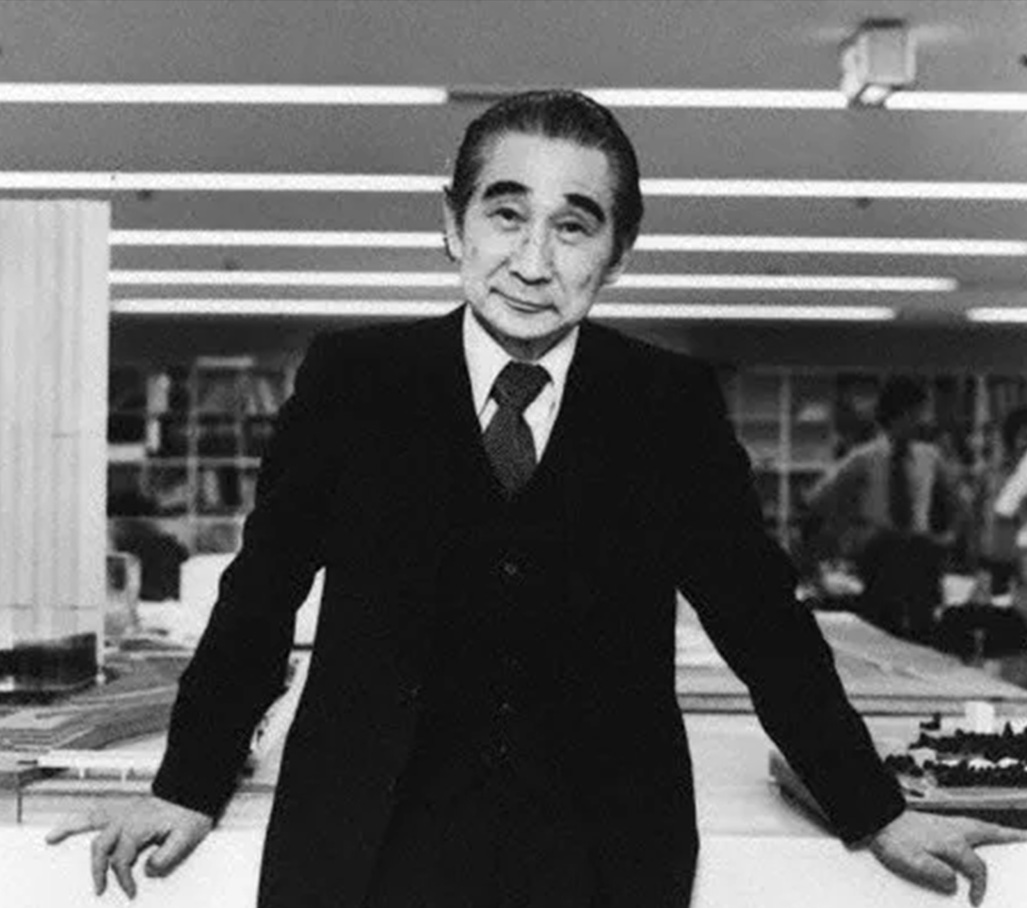Kenzo TangeOur founder
1913-1938: Early Life and EducationKenzo Tange was born in Osaka in 1913. He graduated in 1938 from the Faculty of Engineering, Department of Architecture, at Tokyo Imperial University. Inspired by the work of Le Corbusier, he joined the architectural design office of Kunio Maekawa, one of Le Corbusier’s pupils.
1913年、大阪府に生まれる。
1938年、東京帝国大学工学部建築科を卒業。
ル・コルビュジェに傾倒し、その教え子である前川國男の建築事務所に入る。
1941-1974: Teaching and MentorshipIn 1941, Tange enrolled in graduate school at Tokyo Imperial University. After completing his studies, he taught at his alma mater from 1946 to 1974, eventually establishing and leading the Tange Laboratory.
The laboratory became a center of architectural innovation and produced many leading figures in Japanese architecture, including Takashi Asada, Sachio Otani, Taneo Oki, Koji Kamiya, Fumihiko Maki, Arata Isozaki, Kisho Kurokawa, and Yoshio Taniguchi. Tange also taught internationally at institutions such as the Polytechnic University of Milan, Harvard University, and Tsinghua University in Beijing.
1941年、東京大学大学院に入学し、卒業後、1946年から1974年まで母校で教鞭をとり、「丹下研究室」を主宰。浅田孝、大谷幸夫、沖種郎、神谷宏治、槇文彦、磯崎新、黒川紀章、谷口吉生ら多くの優れた人材を育成するとともに、ミラノ工科大学、ハーバード大学、清華大学など世界各国で教育に携わる。

1949-1950s: Postwar Architecture and International RecognitionIn 1949, Tange won first place in the design competition for Hiroshima Peace Memorial Park and Museum, a project that became a powerful symbol of postwar reconstruction.
Two years later, he was invited to the CIAM (Congrès International d’Architecture Moderne), where he presented his Hiroshima plan and gained international attention.
During the 1950s, Tange became the first Japanese architect to blend traditional Japanese design with modern Western architecture. He designed numerous public buildings, most notably the Kagawa Prefectural Government Office (1958)—a structure that combined the elegance of traditional Japanese architecture with modern concrete construction, setting the standard for government buildings across Japan.
1949年、広島市主催の平和記念公園及び記念館のコンペで1等入選。
1951年、CIAM(近代建築国際会議)に招かれ、広島の計画案を発表、海外の建築界にデビューする。
1950年代は日本的伝統建築と西欧の近代建築のスタイルを融合し、地方自治体の庁舎など公共建築を数多く手掛け、庁舎のプロトタイプと目されている、コンクリート構造でありながら、伝統的建築の美しさを持つ香川県庁舎(1958)を発表する。
1960s: Urban Vision and StructuralismIn 1960, Tange proposed A Plan for Tokyo 1960, a visionary project emphasizing urban reform and a communications-based infrastructure for the rapidly expanding city.
He founded Kenzo Tange and URTEC in 1961, exploring spatial configuration and symbolism, leading to his structuralist approach. Notable works from this era include the Yoyogi National Gymnasium (1964), with its innovative suspension roof, and the striking Tokyo St. Mary’s Cathedral (1964) with its dramatic shell structure.
1960年代には、成長する都市、東京をコミュニケーションのシステムによって捉える構造改革の必要性を強調した「東京計画1960」を提案する。
1961年に丹下健三+都市・建築設計研究所を開設。そのころから「空間と象徴」という問題に取り組み、構造主義を発展させ、当時最大規模の吊り構造による国立屋内総合競技場(1964)とシェル構造による東京カテドラル聖マリア大聖堂(1964)を設計する。
1970s: National and International ProjectsAt the start of the 1970s, Tange designed the master plan for Expo ’70 in Osaka, while expanding his practice internationally with major urban planning and architectural projects worldwide.
1970年代に入ると大阪で開催された、日本万国博覧会・会場マスタープランの設計(1970)など、日本の国家的事業に携わると同時に世界各国で建築及び都市計画に携わるようになる。
1980s-1990s: Landmark Buildings in Japan and AbroadIn 1986, Tange once again won first place in the competition for the Tokyo Metropolitan Government Building, having designed the previous city hall in 1952. The new complex, completed in Shinjuku, became one of Tokyo’s most iconic landmarks. That same year, he unveiled Tokyo Plan 1986, continuing his vision for the city’s future.
As Tokyo Bay developed, Tange completed the Fuji Television Headquarters (1996), a cutting-edge media center that became a symbol of the Odaiba waterfront.
Internationally, his work reshaped city skylines: in Singapore, the OUB Centre (1986) and UOB Plaza (1995) redefined the city’s commercial core, while in Paris, he designed Le Grand Écran (1991) and proposed plans for redeveloping the Place d’Italie.
1986年に行われた新都庁舎の指名競技設計で1等当選し、丸の内にあった旧庁舎に続いて新都庁舎の設計も担当する。また、同年「東京計画1986」を発表。
その後、東京湾の開発が部分的に実現に向けて動き出す中、臨海副都心全体のシンボルとなりうるものとして、台場地区に最先端のメディアセンターというべきフジテレビ本社ビル(1996)が完成する。

Awards and RecognitionTange received numerous honors, including gold medals from the Académie Royale d’Architecture (France), the Royal Institute of British Architects (UK), and the American Institute of Architects (US), as well as the Pour le Mérite (Germany), the Order of Culture (Japan), the Pritzker Architecture Prize (US), and the Légion d’Honneur (France). He was also named a member of the Académie Française.
海外においても、シンガポール都心に建つ超高層ビル群に活気のある新しいスカイラインを与えているOUBセンター(1986)、UOBプラザ(1995)、フランス・パリ13区のイタリア広場に、都市計画的観点から複合施設のグラン・テクラン(1991)など多数の作品を手掛けている。
フランス建築アカデミー、イギリス王立建築家協会、アメリカ建築家協会の各ゴールドメダル、プール・ル・メリット勲章(西ドイツ)、文化勲章(日本)、プリツカー賞、レジオン・ドヌール勲章(フランス)を受賞し、アカデミーフランセーズ正会員(フランス)にも選出されている。
2005: PassingKenzo Tange passed away in March 2005, leaving behind a legacy that transformed both Japanese and global architecture.
2005年3月 没。